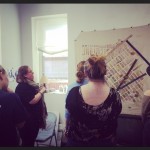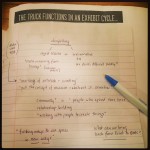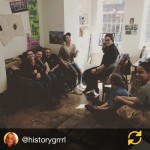Throughout the process of the campus survey, one of the things that really struck me was the different presentations of history within various campus spaces. Bryn Mawr’s history was characterized in radically different lights, depending on the coded “use” of the space.
History in the admissions building, obviously used almost exclusively by the public and prospective students/families, consisted of a big display for Hepburn, a bunch of stock photos of campus architecture, and a plaque dedicated to a chairman. Books written by faculty and alumni were available, but not displayed as prominently and they did not appear to be as handled as the battered Hepburn books.
Other areas are similarly formal. The main floor of Canaday and its nameless photos of benefactors. The cloister and the indescipherable plaques and the enigmatic broken coffin. Thomas Great Hall and the presidential portraits. However, some of these spaces contrast strikingly with themselves. Other floors of Canaday, especially those populated by student carrels, display posters, murals, and other works more representative of how the students view Bryn Mawr and its history. The cloister hosts events, specifically Lantern Night, that is tied in deeply with BMC history. Next to Thomas’ presidents stands Athena and her offerings, a living part of BMC history and tradition.
For me, the coded use of space has intense ramifications on what type of history can be displayed and in what manner. Public-usage spaces are required (by whom? Admins? To me, required by assumption and expectation as much as by administration) to present a specific perspective on Bryn Mawr history for marketing purposes, as well as general acceptance in the community at large. Student-usage spaces, however, can be far more open and present a radically different portrayal of BMC history, one that is more amenable to the current student-held values and aspirations.
Even so, I dare to venture that both present a polarized view of BMC’s history. While there is no “true” history to ever be found in any case, regardless of what one is studying, a more accurate historical representation may be found somewhere between both poles. Regardless, I wonder if that search for accuracy would even prove useful in a public history setting. The end result may only serve to alienate both groups, representing neither fully enough to be embraced on either side. Such representations are professions of identity, as much as they are displays of history. Both sides are saying, differently, “This is who we are, based on who we were.”





